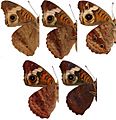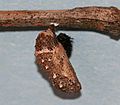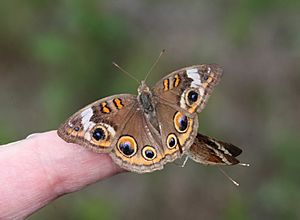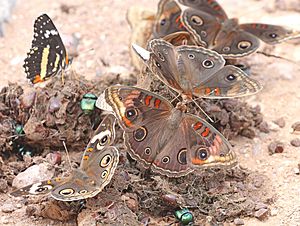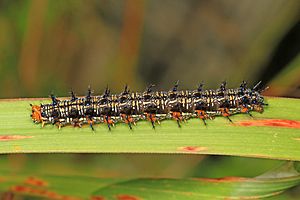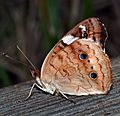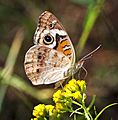Common buckeye facts for kids
Quick facts for kids Common buckeye |
|
|---|---|
 |
|
| Conservation status | |
| Scientific classification |
The Junonia coenia, also known as the common buckeye or just buckeye, is a type of butterfly. It belongs to the Nymphalidae family, which includes many well-known butterflies.
You can find common buckeyes all over the United States, except in the northwest. They are very common in the South, along the California coast, and throughout Central America. These butterflies love open areas with low plants and some bare ground. Scientists believe their ancestors came from Africa and then spread to Asia.
The caterpillars of these butterflies like to eat plants that have special bitter chemicals called iridoid glycosides. These chemicals actually make the caterpillars feel hungry! So, plants like Plantago lanceolata (a type of plantain) are very attractive to them. Female butterflies even look for these chemicals when they lay their eggs. This helps their babies (larvae) get enough of these chemicals.
These iridoid glycosides help the caterpillars grow. They also make the caterpillars less tasty to predators like ants, wasps, birds, and small animals. Predators often prefer to eat caterpillars that don't have many of these chemicals. So, the more iridoid glycosides a caterpillar has, the safer it is from predators. However, eating too many of these chemicals can sometimes make the caterpillars weaker against parasites.
Adult buckeye butterflies like to feed on yellow flowers that haven't changed color yet. This is because the color of a flower can tell the butterfly if it's a good source of nectar. Common buckeye caterpillars usually eat by themselves and don't gather in groups. A virus called Junonia coenia densovirus can also be a problem for young buckeye caterpillars.
Contents
What do Common Buckeyes Look Like?
Adult Butterflies
Common buckeye butterflies are mostly brown. They also have splashes of orange, black, white, blue, and magenta. Their front wings have two orange bars and a white band. This band goes around a big black "eyespot" and a smaller one. Both eyespots have a blue center and an orange mark next to them.
The back wings are mostly brown with an orange band near the edge. They also have two eyespots, one big and one small. These eyespots have black and white outlines and colorful centers with black, blue, magenta, and orange. Sometimes, their wings have a blue-green shimmer. Their wings usually spread about 2 to 2.5 inches (5 to 6.5 cm) wide.
Caterpillars
Common buckeye caterpillars have amazing and detailed colors. Their backs are mostly black with lighter marks (white, gray, beige, or brownish). Their sides have white marks and red-orange spots, and their underside is brown. Their heads are mostly red-orange with black marks on their faces.
They have spines running along their backs and sides, up to 7 on each body part. There are also two small spines on top of their heads. These spines have smaller branches and look a bit shiny blue at the bottom. They also have two pairs of tiny white spines on each body part, near the bottom. Younger caterpillars have less noticeable colors and spines. They can grow up to 4 cm (1 5/8 inches) long.
Other caterpillars, like the painted lady and the Glanville fritillary, look similar and can sometimes be confused with the common buckeye caterpillar.
Pupae (Chrysalises)
Like monarch caterpillars, buckeye caterpillars turn into a pupa (also called a chrysalis). They spin a silk pad on a surface, hang upside down in a "J" shape, and then shed their skin. The chrysalis is mostly brown with beige marks and feels a bit prickly. It has a beige band near the top and another at its "waist." It also has four pairs of beige dots down its back. It is about 18 mm long and 8 mm wide. If you touch it, the chrysalis might wiggle its bottom part.
Where Did They Come From?
The Junonia butterflies likely came from one ancestor in Africa. From there, they spread to Asia. In Asia, they changed and became different species. These species then spread even further to places like Australia, other parts of Africa, and South America. This shows how species can spread out and then develop into new types in different places.
What Do They Eat?
Caterpillars
Buckeye caterpillars eat many different plants. Some of their favorites include the narrowleaf plantain (Plantago lanceolata), the common greater plantain (Plantago major), blue toadflax, false foxglove, Mexican petunia (Ruellia species), the firecracker plant, and Cudweed.
Adult Butterfly Food
Adult buckeye butterflies are picky about the flowers they visit. For example, with Lantana camara flowers, they prefer to feed on the yellow ones. This is because the color of a flower can tell the butterfly how much nectar it has. Butterflies learn over time to visit yellow flowers that are "pre-change" (meaning their color hasn't changed yet). This helps them find the best flowers for nectar. More nectar in a flower can also make the butterfly stay longer.
Laying Eggs
When female butterflies lay eggs (this is called oviposition), they use their sense of taste to find the right leaves. They look for chemicals called iridoid glycosides, which are found in plants like P. lanceolata. These chemicals tell the female that it's a good place to lay eggs. Even a tiny bit of these chemicals can make a female want to lay eggs there. However, they prefer plants with more of these chemicals.
Caterpillars that eat these chemicals get a lot of protection from predators. So, female butterflies that can find plants with more iridoid glycosides help their babies survive better.
How Caterpillars Behave
Buckeye caterpillars usually eat alone. Even if many caterpillars are on the same plant, they don't work together or form groups. They are generally not aggressive. They don't mind other caterpillars being around and usually don't fight if they bump into each other.
Migration
Common buckeyes move south in the fall, usually in September or October. They fly with the wind after cold weather fronts. They don't like the cold and can't survive winter in very cold northern areas. But they fly back north from the south in the spring.
These butterflies also move around locally. They tend to travel more easily between areas that are connected by natural pathways than between unconnected areas. This can help more butterflies move into new places, which can increase the number of butterflies in those habitats.
Who Are Their Enemies?
Predators
Common buckeye butterflies and caterpillars have several predators. These include ants, wasps, birds, and small animals. Predators seem to prefer eating caterpillars that haven't eaten many iridoid glycosides. This means that caterpillars who eat plants with these chemicals are safer. This also encourages female butterflies to lay eggs on plants that have these protective chemicals.
How Chemicals Protect Them
The iridoid glycosides in the caterpillars can affect predators differently. These chemicals can slow down the growth of predators. So, predators might choose to eat caterpillars that don't have these chemicals. Iridoid glycosides help the caterpillars grow while making it harder for predators to grow. This is how these chemicals protect the butterflies.
Viruses
The Junonia coenia densovirus is a virus that infects common buckeye caterpillars. It attacks their dividing cells to spread. This virus has a smooth, sphere-shaped outer shell and contains single-stranded DNA. It belongs to the Parvaviridae family. Scientists have even thought about using this virus as a natural insecticide because it targets only this specific butterfly. This densovirus is special because its DNA strands for different proteins are separated.
Parasites
Eating too many iridoid glycosides can actually weaken the buckeye caterpillar's immune system. This makes them more likely to get sick from parasites and less able to fight them off. So, caterpillars need to balance the protection these chemicals give them with the risk of a weaker immune system. Parasites are a major cause of death for caterpillars, so this balance is very important for their survival.
Immunity
Ants are common predators of J. coenia caterpillars. The chemicals they get from their food are a strong way for them to survive against ants. The more iridoid glycosides a caterpillar has, the less likely it is to be eaten by predators.
How They Sense the World
Taste
To find a good plant for laying eggs, female butterflies look for the right amount of chemicals like catalpol or iridoid glycosides. They "drum" on the plant with their legs. This allows them to poke the plant and "taste" the different chemicals inside. They can do this using special taste sensors on their front legs.
How They Protect Themselves
Automimicry
Caterpillars also use a weak form of automimicry to survive. This means that some caterpillars that have eaten iridoids (making them taste bad to predators) help protect other caterpillars that haven't eaten iridoids (making them tasty). Predators might avoid all buckeye caterpillars because some taste bad. However, this protection isn't very strong. It might also just mean that predators avoid this type of caterpillar altogether, rather than picking and choosing.
Images for kids
See also
 In Spanish: Junonia coenia para niños
In Spanish: Junonia coenia para niños




